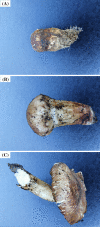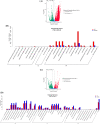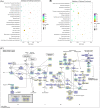Comparative analysis of transcriptomes revealed the molecular mechanism of development of Tricholoma matsutake at different stages of fruiting bodies
- PMID: 32582456
- PMCID: PMC7297875
- DOI: 10.1007/s10068-020-00732-8
Comparative analysis of transcriptomes revealed the molecular mechanism of development of Tricholoma matsutake at different stages of fruiting bodies
Abstract
The purpose of the study is to investigate the molecular mechanisms of development of Tricholoma matsutake fruiting body at the primordial stage (TM-1), the intermediate stage (TM-2) and the mature stage (TM-3) using RNA-Seq sequencing technology. The analysis of gene expression level revealed that the Spn2 and Eef1a1 gene were the key genes in the primordial stage of T. matsutake by regulating cytokinesis, protein synthesis, and cell growth. And the Ubc, Atp6, Cytb, and Pth2 gene were the key genes in the mature stage of T. matsutake by regulating energy metabolism and protein synthesis. Differential expression genes (DEGs) analysis results showed that Cdc28, Rad53, Dun1, Pho85 and Pho81 were the key DEGs regulating cell cycle genes of T. matsutake from primordial stage to intermediate stage. And APC, Cyr1, Cdc45, Spo11 and Rec8 genes were the key DEGs for the meiosis and sporogenesis of T. matsutake from the intermediate stage to the mature stage.
Keywords: Development; Molecular mechanism; RNA-sequencing; Transcriptome; Tricholoma matsutake.
© The Korean Society of Food Science and Technology 2020.
Figures





Similar articles
-
Quantitative transcriptomic and metabolomic analyses reveal the changes in Tricholoma matsutake fruiting bodies during cold storage.Food Chem. 2022 Jul 1;381:132292. doi: 10.1016/j.foodchem.2022.132292. Epub 2022 Feb 1. Food Chem. 2022. PMID: 35124491
-
Analysis of Bacterial Diversity and Communities Associated with Tricholoma matsutake Fruiting Bodies by Barcoded Pyrosequencing in Sichuan Province, Southwest China.J Microbiol Biotechnol. 2016 Jan;26(1):89-98. doi: 10.4014/jmb.1505.05008. J Microbiol Biotechnol. 2016. PMID: 26428733
-
Chemical compositions and volatile compounds of Tricholoma matsutake from different geographical areas at different stages of maturity.Food Sci Biotechnol. 2016 Feb 29;25(1):71-77. doi: 10.1007/s10068-016-0010-1. eCollection 2016. Food Sci Biotechnol. 2016. PMID: 30263238 Free PMC article.
-
Identification of upregulated genes in Tricholoma matsutake mycorrhiza.FEMS Microbiol Lett. 2022 Sep 20;369(1):fnac085. doi: 10.1093/femsle/fnac085. FEMS Microbiol Lett. 2022. PMID: 36029515
-
Insights into health promoting effects and myochemical profiles of pine mushroom Tricholoma matsutake.Crit Rev Food Sci Nutr. 2023;63(22):5698-5723. doi: 10.1080/10408398.2021.2023857. Epub 2022 Jan 5. Crit Rev Food Sci Nutr. 2023. PMID: 34985354 Review.
Cited by
-
Whole-Genome and Transcriptome Sequencing of Phlebopus portentosus Reveals Its Associated Ectomycorrhizal Niche and Conserved Pathways Involved in Fruiting Body Development.Front Microbiol. 2021 Sep 29;12:732458. doi: 10.3389/fmicb.2021.732458. eCollection 2021. Front Microbiol. 2021. PMID: 34659161 Free PMC article.
-
Lessons on fruiting body morphogenesis from genomes and transcriptomes of Agaricomycetes.Stud Mycol. 2023 Jul;104:1-85. doi: 10.3114/sim.2022.104.01. Epub 2023 Jan 31. Stud Mycol. 2023. PMID: 37351542 Free PMC article.
-
A Review of Genomic, Transcriptomic, and Proteomic Applications in Edible Fungi Biology: Current Status and Future Directions.J Fungi (Basel). 2025 May 30;11(6):422. doi: 10.3390/jof11060422. J Fungi (Basel). 2025. PMID: 40558935 Free PMC article. Review.
-
Transcriptome Profiling Reveals Candidate Genes Related to Stipe Gradient Elongation of Flammulina filiformis.J Fungi (Basel). 2022 Dec 31;9(1):64. doi: 10.3390/jof9010064. J Fungi (Basel). 2022. PMID: 36675885 Free PMC article.
-
Comparative analysis of proteomes and transcriptomes revealed the molecular mechanism of development and nutrition of Pleurotus giganteus at different fruiting body development stages.Front Nutr. 2023 Jul 21;10:1197983. doi: 10.3389/fnut.2023.1197983. eCollection 2023. Front Nutr. 2023. PMID: 37545588 Free PMC article.
References
-
- Addi C, Bai J, Echard A. Actin, microtubule, septin and ESCRT filament remodeling during late steps of cytokinesis. Curr. Opin. Cell Biol. 2018;50:27–34. - PubMed
-
- Ando A, Harada A, Miura K, Tamai Y. A gene encoding a hydrophobin, fvh1, is specifically expressed after the induction of fruiting in the edible mushroom Flammulina velutipes. Curr. Genet. 2001;39:190–197. - PubMed
-
- Arima T, Yamamoto M, Hirata A, Kawano S, Kamada T. The eln3 gene involved in fruiting body morphogenesis of Coprinus cinereus encodes a putative membrane protein with a general glycosyltransferase domain. Fungal Genet. Biol. 2004;41:805–812. - PubMed
LinkOut - more resources
Full Text Sources
Miscellaneous
